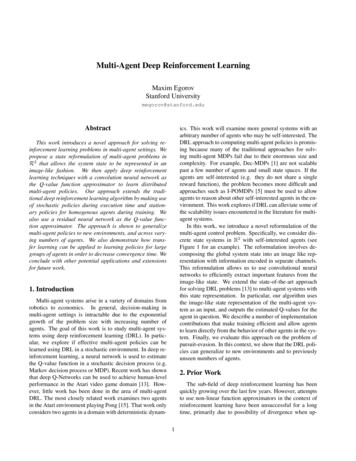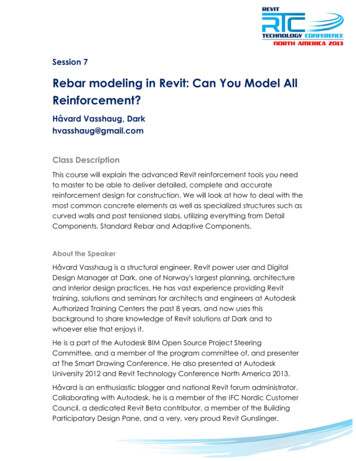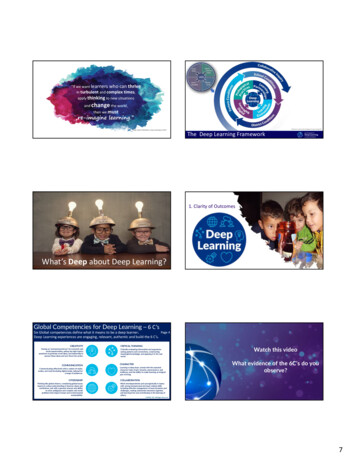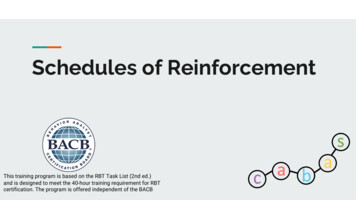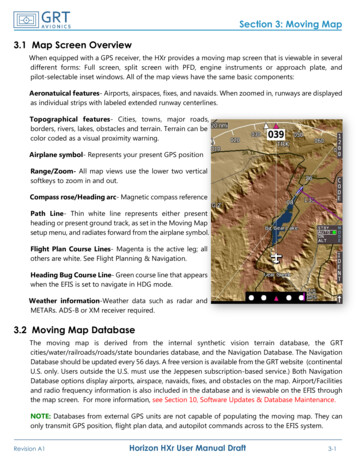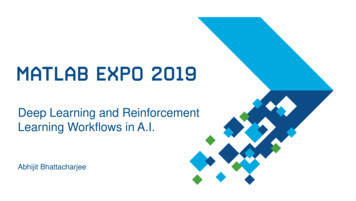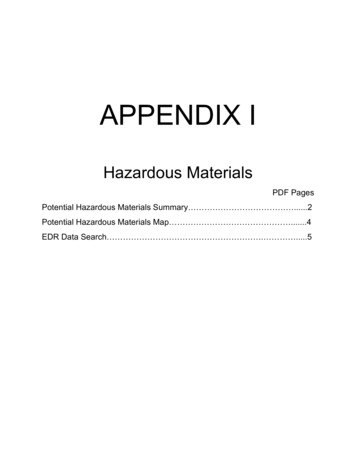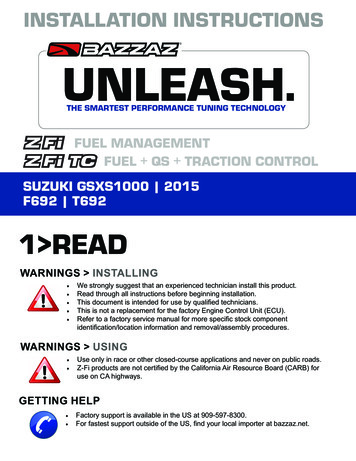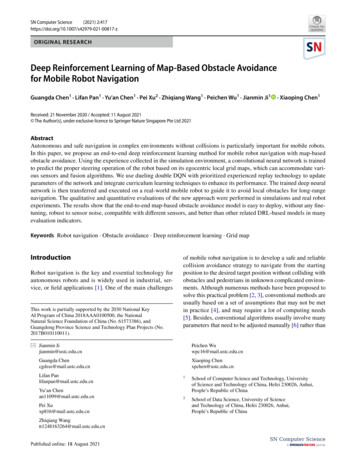
Transcription
SN Computer Science(2021) GINAL RESEARCHDeep Reinforcement Learning of Map‑Based Obstacle Avoidancefor Mobile Robot NavigationGuangda Chen1 · Lifan Pan1 · Yu’an Chen1 · Pei Xu2 · Zhiqiang Wang1 · Peichen Wu1 · Jianmin Ji1· Xiaoping Chen1Received: 21 November 2020 / Accepted: 11 August 2021 The Author(s), under exclusive licence to Springer Nature Singapore Pte Ltd 2021AbstractAutonomous and safe navigation in complex environments without collisions is particularly important for mobile robots.In this paper, we propose an end-to-end deep reinforcement learning method for mobile robot navigation with map-basedobstacle avoidance. Using the experience collected in the simulation environment, a convolutional neural network is trainedto predict the proper steering operation of the robot based on its egocentric local grid maps, which can accommodate various sensors and fusion algorithms. We use dueling double DQN with prioritized experienced replay technology to updateparameters of the network and integrate curriculum learning techniques to enhance its performance. The trained deep neuralnetwork is then transferred and executed on a real-world mobile robot to guide it to avoid local obstacles for long-rangenavigation. The qualitative and quantitative evaluations of the new approach were performed in simulations and real robotexperiments. The results show that the end-to-end map-based obstacle avoidance model is easy to deploy, without any finetuning, robust to sensor noise, compatible with different sensors, and better than other related DRL-based models in manyevaluation indicators.Keywords Robot navigation · Obstacle avoidance · Deep reinforcement learning · Grid mapIntroductionRobot navigation is the key and essential technology forautonomous robots and is widely used in industrial, service, or field applications [1]. One of the main challengesThis work is partially supported by the 2030 National KeyAI Program of China 2018AAA0100500, the NationalNatural Science Foundation of China (No. 61573386), andGuangdong Province Science and Technology Plan Projects (No.2017B010110011).of mobile robot navigation is to develop a safe and reliablecollision avoidance strategy to navigate from the startingposition to the desired target position without colliding withobstacles and pedestrians in unknown complicated environments. Although numerous methods have been proposed tosolve this practical problem [2, 3], conventional methods areusually based on a set of assumptions that may not be metin practice [4], and may require a lot of computing needs[5]. Besides, conventional algorithms usually involve manyparameters that need to be adjusted manually [6] rather than* Jianmin Jijianmin@ustc.edu.cnPeichen Wuwpc16@mail.ustc.edu.cnGuangda Chencgdsss@mail.ustc.edu.cnLifan Panlifanpan@mail.ustc.edu.cnYu’an Chenan11099@mail.ustc.edu.cnPei Xuxp816@mail.ustc.edu.cnXiaoping Chenxpchen@ustc.edu.cn1School of Computer Science and Technology, Universityof Science and Technology of China, Hefei 230026, Anhui,People’s Republic of China2School of Data Science, University of Scienceand Technology of China, Hefei 230026, Anhui,People’s Republic of ChinaZhiqiang Wangtt1248163264@mail.ustc.edu.cnSN Computer ScienceVol.:(0123456789)
417Page 2 of 14being able to learn automatically from past experience [7].These methods are difficult to generalize well to unpredictable situations.Recently, several supervised and self-supervised deeplearning methods have been applied to robot navigation.However, these methods have some limitations that it is difficult to widely use in real robot environments. For example,the training of the supervised learning approaches requiresa massive manually labeled dataset. On the other hand,deep reinforcement learning (DRL) methods have achievedsignificant success in many challenging tasks, such as Gogame [8], video games [9], and robotics [10]. Unlike previous supervised learning methods, DRL-based methods learnfrom a large number of trials and corresponding feedback(rewards), rather than from labeled data. To learn sophisticated control strategies through reinforcement learning, therobot needs to interact with the training environment for along time to accumulate experience about the consequencesof taking different actions in different states. Collecting suchinteractive data in the real world is very expensive, timeconsuming, and sometimes impossible due to security issues[11]. For example, Kahn et al. [7] proposed a generalizedcomputational graph that includes model-based methods andvalue-based model-free methods and then instantiated thegraph to form a navigation model that is learned from theoriginal image and is highly sample efficient. However, ittakes tens of hours of destructive self-supervised training tonavigate only tens of meters without collision in an indoorenvironment. Because learning good policies requires a lotof trials, training in simulation worlds is more appropriatethan gaining experience from the real world. The learnedpolicies can be transferred according to the close correspondence between the simulator and the real world. Andthere are different transfer abilities to the real world betweendifferent types of input data.According to the type of input perception data, the existingobstacle avoidance methods of mobile robots based on deepreinforcement learning can be roughly divided into two categories: agent-level inputs and sensor-level inputs. In particular, anagent-level method takes into account positions and the movement data, like velocities, accelerations and paths, of obstaclesor other agents. Although the agent-level methods have thedisadvantages of requiring precise and complex front-end perception processing modules, they still have the advantages ofsensor type independence (which can be adapted to differentfront-end perception modules), easy-to-design training simulation environment, and easy migration to the real environment.However, a sensor-level method uses the sensor data directly.Compared with agent-level methods, sensor-level methods donot require a complex and time-consuming front-end perception module. However, because sensor data are not abstracted,such methods are generally not compatible with other sensors,or even multi-sensors carried by robots. Currently, more andSN Computer ScienceSN Computer Science(2021) 2:417more robots are equipped with different and complementarysensors and capable of navigating in complex environmentswith high autonomy and safety guarantee [12]. But all existing sensor-level works depend on specific sensor types andconfigurations.In this paper, we propose an end-to-end map-based deepreinforcement learning algorithm to improve the performance of mobile robot decision-making in complicated environments, which directly maps local probabilistic grid mapswith target position and robot velocity to an agent’s steering commands. Compared with previous works on DRLbased obstacle avoidance, our motion planner is based onegocentric local grid maps to represent observed surroundings, which enables the learned collision avoidance policyto handle different types of sensor input efficiently, such asthe multi-sensor information from 2D/3D range scan findersor RGB-D cameras. And our trained CNN-based policy iseasily transferred and executed on a real-world mobile robotto guide it to avoid local obstacles for long-range navigationand robust to sensor noise. We evaluate our DRL agents bothin simulation and on robot qualitatively and quantitatively.Our results show the improvement in multiple indicatorsover the DRL-based obstacle avoidance policy.Our main contributions are summarized as follows:– Formulate the obstacle avoidance of mobile robots as a deepreinforcement learning problem based on the generated gridmap, which can be directly transferred to real-world environments without adjusting any parameters, compatiblewith different sensors and robust to sensor noise.– Integrate curriculum learning technique to enhance theperformance of dueling double DQN with a prioritizedexperienced replay.– Conduct a variety of simulation and real-world experiments to demonstrate the high adaptability of our modelto different sensor configurations and environments.The rest of this article is organized as follows. “RelatedWork” introduces our related work. “System Structure”describes the structure of the DRL-based navigation system. “Map-Based Obstacle Avoidance” introduces the deepreinforcement learning algorithm for obstacle avoidancebased on egocentric local grid maps. “Experiments” presents the experimental results and “Conclusion” gives theconclusions.This paper is a significantly expanded version of our previous conference paper [13].
SN Computer Science(2021) 2:417Related WorkIn recent years, deep neural networks have been widelyapplied in the supervised learning paradigm to train acollision avoidance policy that maps sensor input to therobot’s control commands to navigate a robot in environments with static obstacles. Learning-based obstacle avoidance approaches try to optimize a parameterized policy for collision avoidance from experiences invarious environments. Giusti et al. [14] used deep neuralnetworks to classify the input color images to determinewhich action would keep the quadrotor on the trail. Toobtain a large number of training samples, they equippedthe hikers with three head-mounted cameras. The hikersthen glanced ahead and quickly walked on the mountainpath to collect the training data. Gandhi et al. [15] createdtens of thousands of crashes to make one of the biggestdrone crash datasets for training unmanned aerial vehiclesto fly. Tai et al. [16] proposed a hierarchical structure thatcombines a decision-making process with a convolutionalneural network, which takes the original depth image asthe input. They use expert teaching methods to remotelycontrol the robot to avoid obstacles and collect experiencedata manually. Although the trouble of manually collectinglabeled data can be alleviated by self-supervised learning,the performance of learned models is largely limited by thestrategy of generating training labels. Pfeiffer et al. [17]proposed a model capable of learning complex mappingsfrom raw 2D laser range results to the steering commandsof a mobile indoor robot. During the generation of training data, the robot is driven to a randomly selected targetposition on the training map. The simulated 2D laser data,relative target positions and, steering velocities generatedby conventional obstacle avoidance methods (dynamicwindow method [18]) are recorded. The performance ofthe learned models is largely limited by the generatingprocess of training data (steering commands) from conventional methods, and thus the robot is just capable ofpassing some simple static obstacles in the very emptycorridor. Liu et al. [19] proposed a deep imitation learningmethod for obstacle avoidance based on local grid maps.To improve the robustness of the policy, they expanded thetraining data set with the artificially generated map, whicheffectively alleviates the shortage of training samples innormal demonstrations. However, the robot using theirmethod is only tested in an empty and static environment,and thus the method proposed by Liu et al. [19] is difficultto be extended to complicated environments.On the other hand, obstacle avoidance algorithms basedon deep reinforcement learning have attracted widespreadattention. The existing DRL-based methods are roughlydivided into two categories: agent-level inputs andPage 3 of 14417sensor-level inputs. In particular, an agent-level methodtakes into account positions and the movement data, likevelocities, accelerations and paths, of obstacles or otheragents. However, a sensor-level method uses the sensordata directly. As representatives of agent-level methods,Chen et al. [20] trained an agent-level collision avoidancepolicy of mobile robots using deep reinforcement learning. They learned a value function for two agents, whichexplicitly maps the agent’s own state and the states of itsneighbors into a collision-free action. And then they generalize the policy of two agents to the policy of multipleagents. However, their method requires perfect perceptiondata, and the network input has dimensional constraints. Intheir follow-up work [21], multiple sensors were deployedto estimate the states of nearby pedestrians and obstacles.Such a complex perception and decision-making systemnot only requires expensive online calculations, but alsomakes the entire system less robust to perceptual uncertainty. Although the agent-level methods have the disadvantages of requiring precise and complex front-endperception processing modules, they still have the advantages of sensor type independence (which can be adaptedto different front-end perception modules), easy to designsimulation environment training, and easy migration tothe real environment.As for sensor-level input, the types of sensor data usedin DRL-based obstacle avoidance mainly include 2D laserranges, depth images and color images. Tai et al. [22] proposed a learning-based map-free motion planner by takingsparse 10-dimensional range findings and a target positionrelative to the mobile robot coordinate system as inputs andtaking steering commands as outputs. Long et al. [23] proposed a decentralized sensor-level collision avoidance policyfor multi-robot systems, which directly maps the measurement values of the original 2D laser sensor to the steeringcommands of the agents. Xie et al. [11] proposed a novelassisted reinforcement learning framework in which classiccontrollers are used as an alternative and switchable strategyto speed up DRL training. Furthermore, their neural networkalso includes 1D convolutional network architectures, whichis used to process raw perception data captured by the 2Dlaser scanner. The 2D laser-based method is competitivein being portable to the real world because the differencebetween the laser data in the simulator and the real worldis very small. However, 2D sensing data cannot cope withcomplex 3D environments. Instead, vision sensors can provide 3D sensing information. However, during the trainingprocess, RGB images will encounter significant deviationsfrom the actual situation and the simulated environment,which leads to a very limited generalization of various situations. In [24], models trained in the simulator are migratedthrough the conversion of actual and simulated images, buttheir experimental environment is a single football field andSN Computer Science
417Page 4 of 14cannot be generalized to all real environments. Comparedwith RGB images, the depth image is easier to transfer thetrained model to actual deployment, because the depth imageis agnostic to texture variation and thus has a better visualfidelity, thus greatly reducing the burden of transferring thetrained model to actual deployment [25]. Zhang et al. [26]proposed a deep reinforcement learning algorithm based ondepth images, which can learn to transfer knowledge frompreviously mastered obstacle avoidance tasks to new problem instances. Their algorithm greatly reduces the learning time required after solving the first task instance, whichmakes it easy to adapt to the changing environment. Currently, all existing sensor-level work depends on specificsensor types and configurations. However, equipped withdifferent and complementary sensors, the robots are capableof navigating in complex environments with high autonomyand safety guarantee [12]. Compared with agent-level methods, sensor-level methods do not require a complex andtime-consuming front-end perception module. However,because sensor data are not abstracted, such methods aregenerally not compatible with other sensors, or even multisensors carried by robots.System StructureOur proposed DRL-based mobile robot navigation systemcontains six modules. As shown in Fig. 1, the simultaneous localization and mapping (SLAM) module builds anenvironment map based on sensor data and can estimatethe robot’s position and speed in the map at the same time.When the target location is received, the global path planner module generates a path or a series of local targetpoints from the current location to the target location basedon a pre-built map from the SLAM module. To deal withdynamic and complex environments, a safe and robust collision avoidance module is needed in an unknown clutteredenvironment. In addition to the local target points from thepath planning module and the robot speed provided by theSLAM positioning module, our local collision avoidanceFig. 1 The DRL-based navigation system for autonomous robotsSN Computer ScienceSN Computer Science(2021) 2:417module also needs the surrounding environment information, which is represented as the egocentric grid map generated by the grid map generator module based on varioussensor data. In general, our DRL-based local planner module needs to input the speed of the robot generated by theSLAM module, the location of the local target generated bythe global path planner, and the grid map of the map generator module that can fuse multi-sensor information, andoutputs the control commands of the robot: linear velocity vand angular velocity w. Finally, the output speed commandis executed by the base controller module which maps thecontrol speed to the instructions of the wheel motor basedon the specific kinematics of the robot.Map‑Based Obstacle AvoidanceWe begin this section by introducing the mathematical definition of the local obstacle avoidance problem. Next, wedescribe the DQN reinforcement learning algorithm withimprovement methods (including double DQN, dueling network and prioritized experienced replay) and key ingredients (including the observation space, action space, rewardfunction and network architecture). Finally, the curriculumlearning technique is introduced.Problem FormulationAt each timestamp t, given a frame of sensing data st , a localtarget position 𝐩g in the robot coordinate system and the linear velocity vt , angular velocity 𝜔t of the robot, the proposedmap-based local obstacle avoidance policy can provides avelocity action command at as follows:𝐌t f𝜆 (st ),(1)at 𝜋𝜃 (𝐌t , 𝐩g , vt , 𝜔t ),(2)where 𝜆 and 𝜃 are the parameters of grid map generator andpolicy model, respectively. Specifically, the grid map 𝐌t isconstructed as a collection of robot configurations and theperceived surrounding obstacles, which will be explainedbelow.Therefore, the robot collision avoidance problem canbe simply expressed as a sequential decision problem. Thesequential decision problem involving observing observations 𝐨t [𝐌t , 𝐩g , vt , 𝜔t ] and the actions (velocities)at [vt 1 , 𝜔t 1 ] (t 0 tg ) can be regarded as a trajectoryl from starting position 𝐩s to desired target 𝐩g , where tg isthe travel time. Our goal is to minimize the expectation ofarrival time and take into account that the robot will not collide with other objects in the environment, which is definedas:
SN Computer SciencePage 5 of 14(2021) 2:417{argmin𝔼[tg at 𝜋𝜃 (𝐨t ),𝜋𝜃𝐩t 𝐩t 1 at 𝛥t,(3) k [1, N] (𝐩o )k 𝛺(𝐩t )],where 𝐩o is the position of obstacle and 𝛺 indicates the sizeand shape of the robot, (𝐩o )k 𝛺(𝐩t ) represents that therobot with 𝛺 shape does not collide with any obstacle.Dueling DDQN with Prioritized Experienced ReplayThe Markov Decision Process (MDP) provides a mathematical formulation and framework for modeling stochasticplanning and decision-making problems under uncertainty.MDP is a five-tuple M (S, A, P, R, 𝛾), where S representsthe state space, A indicates the action space, and P is thetransition function, which describes the probability distribution of the next state when the action a is taken in thecurrent state s, R represents the reward function, and 𝛾 indicates the discount factor. In the MDP problem, the policy𝜋(a s) represents the basis on which an agent takes action,the agent will choose an action based on policy 𝜋(a s). Themost common policy expression is a conditional probabilitydistribution, which is the probability of taking action a instate s, i.e. 𝜋(a s) P(At a St s). At this time, the actionwith a high probability is selected by an agent with a higherprobability. The quality of policy 𝜋 can be evaluated by theaction-value function (Q-value) defined as:[ ] 𝜋𝜋tQ (s, a) 𝔼𝛾 R(st , at ) s0 s, a0 a .(4)t 0That is, the Q-value function is the expectation of the sumof discounted rewards. The goal of the agent is to maximizethe expected sum of future discounted rewards, which can beachieved by using the Q-learning algorithm that iterativelyapproximates the optimal Q-value function by the Bellmanequation:Q (st , at ) R(st , at ) 𝛾maxQ(st 1 , at 1 ).at 1(5)Combined with deep a neural network, the Deep Q Network(DQN) enables conventional reinforcement learning to copewith complex high-dimensional decision-making problems.Generally, the DQN algorithm contains two deep neural networks, including an online deep neural network with parameters 𝜃 which are constantly updated by minimizing the lossfunction (yt Q(st , at ;𝜃 ))2, and a separate target deep neuralnetwork with parameters 𝜃 ′, which are fixed for generatingTemporal-Difference (TD) targets and regularly assigned bythose of the online deep neural network. The yt in the lossfunction is calculated as follows:yt rtif episode ends.rt 𝛾maxQ(st 1 , at 1 ;𝜃 ) otherwiseat 1417(6)Due to the maximization step in Eq. (6), traditional Q-learning is affected by overestimation bias, which can hurt thelearning process. Double Q-learning [27] solves this overestimation problem by decoupling by choosing actions from itsevaluation in the maximization performed for the bootstraptarget. Therefore, if the episode does not end, yt in the aboveformula is rewritten as follows:yt rt 𝛾Q(st 1 , argmaxQ(st 1 , at 1 ;𝜃);𝜃 ).at 1(7)In this work, dueling networks [28] and prioritized experienced replay [29] are also deployed for more reliableestimation of Q-values and sampling efficiency of replaybuffer, respectively. Dueling DQN proposes a new networkarchitecture. They divided the Q-value estimation into twoparts: V(s) and Adv(s, a), one is to estimate how good it isto be in state s, and the other is to estimate the advantage oftaking action a in that state. The two parts are based on thesame front-end perception module of the neural network andfinally fused to represent the final Q-value. The result of thisarchitecture is that state values can be learned independentlywithout being confused by the effects of action advantages.This in particular leads to the identification of state information where actions have no effect on.The idea of Prioritized Experienced Replay is to prioritizeexperiences that contain more important information thanothers. Each experience is stored with an additional priority value, so the higher priority experiences have a highersampling probability, and have the opportunity to stay inthe buffer longer than other experiences. As importancemeasure, the TD error can be used. It can be expected thatif the TD error is high, the agent can learn more from thecorresponding experience, because the agent’s performanceis better or worse than expected. Prioritized ExperiencedReplay can speed up the learning process.In the following, we describe the key ingredients of theDQN reinforcement learning algorithm, including the detailsof the observation and action space, the reward function andthe network architecture.Observation SpaceAs mentioned in “Problem Formulation”, the observation𝐨t includes the generated grid maps 𝐌t which is compatible with multiple sensors and easy to simulate and migrateto real robots, the relative goal position 𝐩′g and the currentvelocity of the robot 𝐯t . Specifically, 𝐌t represents the gridmap images with the size and shape of robot generatedfrom a 2D laser scanner or other sensors. The relative targetSN Computer Science
417Page 6 of 14position 𝐩′g is a two-dimensional vector representing the target coordinates relative to the current position of the robot.The observation 𝐯t includes the current linear velocity andangular velocity of the differentially driven robot.We use layered grid maps [30] to represent the environmental information perceived by multiple sensors. Then,through the map generator module, we obtain the state maps𝐌t by drawing the robot configuration (size and shape) intothe layered grid maps. Figure 2b shows an example of a gridmap generated from a single 2D laser scanner.Action SpaceIn this work, the action space of the robot agent is a set ofallowable velocity in discrete space. The action of the differential robot only consists of two parts: translation velocity and rotation velocity, i.e. 𝐚t [vt , wt ]. In the process ofimplementation, considering the kinematics and practicalapplication of the robot, we set the range of the rotationvelocity 𝜔 [ 0.9, 0.6, 0.3, 0.0, 0.3, 0.6, 0.9] (in radiansper second) and the translation velocity v [0.0, 0.2, 0.4, 0.6](in meters per second) . It is worth mentioning that sincethe laser rangefinder carried by our robot cannot cover theback of the robot, it is not allowed to move backward (i.e.v 0.0).SN Computer Science(2021) 2:417point, the larger the value of (rg )t , the further away from thetarget point, the smaller the value of (rg )t . That is‖‖ ‖‖(rg )t 𝜖(‖𝐩t 1 𝐩g ‖ ‖𝐩t 𝐩g ‖).‖‖ ‖‖(8)In addition, our objective is to avoid collisions during navigation and minimize the average arrival time of the robot.The reward r at time step t is a sum of four terms: rg , ra , rcand rs . That isrt (rg )t (ra )t (rc )t (rs )t .(9)In particular, when the robot reaches the target point, therobot is awarded by (ra )t:{‖‖rarr if‖𝐩t 𝐩g ‖ 0.2a‖‖.(r )t (10)0 otherwiseIf the robot collides with other obstacles, it will be punishedby (rc )t:{rcol if collisionc(r )t .(11)0 otherwiseAnd we also give robots a small fixed penalty rs at each step.We set rarr 500, 𝜖 10, rcol – 500 and rs 5 in thetraining procedure.RewardNetwork ArchitectureThe objective in reinforcement learning is to maximizeexpected discounted long-term return and the reward function in reinforcement learning implicitly specifies what theagent is encouraged to do. In our long-distance obstacleavoidance task, the reward signal is often weak and sparseunless the target point is reached or a collision occurs. In thiswork, the reward shaping technique [31] is used to solve thisproblem by adding an extra reward signal (rg )t based on priorknowledge. The value of (rg )t indicates that the target pointis attractive to the agent. Specifically, the closer to the targetFig. 2 Gazebo training environments (left) and corresponding gridmap displayed by Rviz (right)SN Computer ScienceWe define a deep convolutional neural network that represents the action-value function for each discrete action. Theinput of the neural network has three local maps 𝐌, whichhave 60 60 3 gray pixels and a four-dimensional vectorwith local target 𝐩′g and robot speed 𝐯. The output of the network is the Q values of each discrete action. The architectureof the deep Q value network is shown in Fig. 3. The inputgrid maps are fed into an 8 8 convolution layer with stride4, then followed by a 4 4 convolution layer with stride 2and a 3 3 convolution layer with stride 1. The local targetand the robot speed form a four-dimensional vector, which isprocessed by a fully connected layer, and then the output istiled to a special dimension and added to the response mapof the processed grid maps. The results are then processedby three 3 3 convolution layers with stride 1 and two fullyconnected layers with 512, 512 units, respectively, and thenfed into the dueling network architecture, which divides theQ value estimation into two parts: V(s) and Adv(s, a), one isto estimate how good it is to be in state s, and the other is toestimate the advantage of taking action a in that state. Thetwo parts are based on the same front-end perception moduleof neural network and finally fused together to represent thefinal Q value of 28 discrete actions. Once trained the network can predict Q values for different actions in the input
SN Computer SciencePage 7 of 14(2021) 2:417417Fig. 3 The architecture of our CNN-based dueling DQN network. This network takes three local maps and a vector with a local goal and robotvelocity as input and outputs the Q values of 28 discrete actionsstate (three local maps 𝐌 , local goal 𝐩′g and robot velocity𝐯 ). The action with the maximum Q value will be selectedand executed by the obstacle avoidance module.Curriculum LearningCurriculum learning [32] aims to improve learning performance by designing appropriate curriculums for progressive learners from simple to difficult. Elman et al. [33] putforward the idea that a curriculum of progressively hardertasks could significantly accelerate a neural network’s training. And curriculum learning has recently become prevalentin the machine learning field, which assumes that the curriculum learning can improve the convergence speed of thetraining process and find a better local minimum value thanthe existing solvers. In this work, we use Gazebo simulator[34] to build a training world with multiple obstacles. Asthe training progresses, we gradually increase the number ofobstacles in the environment and also increase the distancefrom the starting point of the target point gradually. Thismakes our strategy training from easy situation to difficultones. At the same time, the position of each obstacle and thestart and endpoints of the robot are automatically randomduring all training episodes. One training scene is shownin Fig. 2a.obstacle avoidance module in the long-range navigationexperiment at the end of “Navigation in real world”. Inother experiments, we only use the local obstacle avoidancemodule t
the training of the supervised learning approaches requires a massive manually labeled dataset. On the other hand, deep reinforcement learning (DRL) methods have achieved signicant success in many challenging tasks, such as Go game [8], video games [9], and robotics [10]. Unlike previ-ous supervised learning methods, DRL-based methods learn
